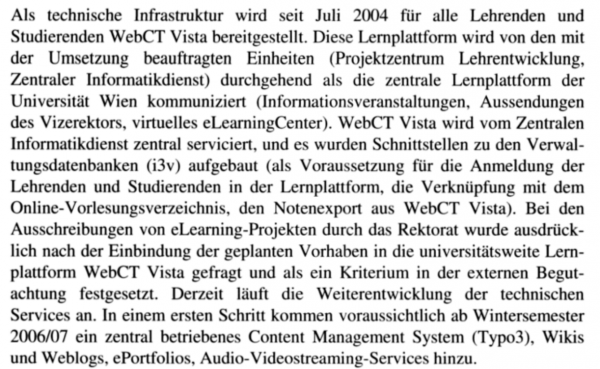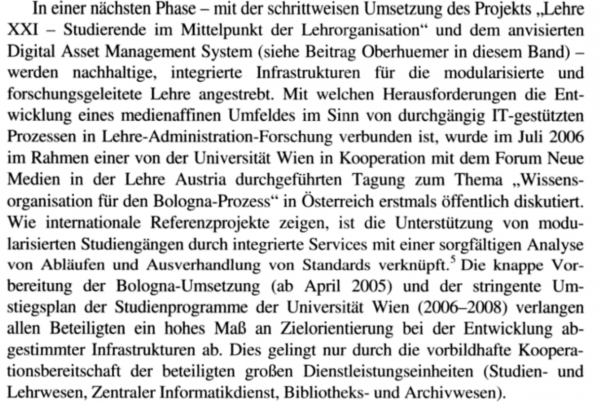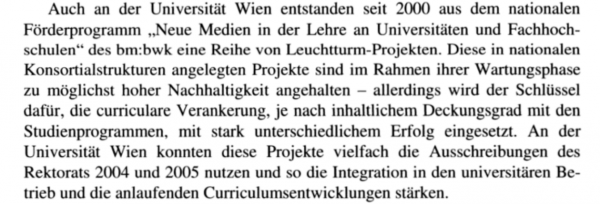Mail, Telnet, Chat, MUD (BD14)
Auszüge aus H.Hrachovec RFCs, MOOs, LMSs: Assorted Educational Devices
Ein Taufakt
Origins are auratic places or events. This holds true both for high and low culture. The socalled "birth of an idea" is just as likely to be a distinguished event as the rise of a pop star. The same thing does not seem to hold for engineering, yet it is difficult to avoid a shiver of awe and recognition when reading the opening sentence of John Postel's "Request for Comments" #821. We are dealing with the foundational document of what was to become electronic mail. The document is dated August 1982 and it starts off with the following remark:
- "The objective of Simple Mail Transfer Protocol (SMTP) is to transfer mail reliably and efficiently."
The sentence seems inconspicuous at first glance. Given the common concept of "mail" the protocol is supposed to ensure its implementation in a networked environment. But there is more beneath the surface of this plain, no-nonsense statement. Notice the implicit discrepancy of cultures. There have been countless attempts to "transfer mail reliably and efficiently" within the framework of traditional services. John Postel refers back to precedents as he introduces a new development.
This is the treshhold at which mail enters the realm of telecommunication. One might call it an act of baptism. We are to be given the outlines of the "Simple Mail Transfer Protocol". "Mail" is no homonym like "Paris" in "Paris, Texas". The working of the term is closer to "New England" which indicates the transference of a certain set of social and cognitive attitudes into a largely unknown environment.
There is no paper involved in this kind of "mail", to pick just the most obvious difference. Sociohistorical projections and questions of technological design are inextricably interwoven at the very beginning of this new area as engineers apply their common sense understanding of mail to a context lacking the appropriate precedents.
Universitätsverwaltung
A rich literature on adapting the classroom to the challenge of computer-assisted teaching has emerged and coping with the various social implications of what started out as engineering rules turns out to be an important issue. The situation is paradigmatic for an assessment of how the IT-market is determining common sense in rich Western countries. Big companies charge universities considerable sums for e-learning platforms that are supposed to boost pedagogical performance and save expenditure for teaching staff.
Consider this variant of Postel's dictum:
- "The objective of e-learning platforms is to teach students reliably and efficiently."
Prozesskommuniktion
SMTP defines the rules that two relays of data-exchange have to obey in order to be considered "transferring mail". The interesting question then becomes: what features of the historical mail system are taken up by Postel's model and how they are implemented in the digital realm? Its pretty straightforward.
SMTP defines a user mail request addressed towards a receiver. The SMTP-user is a digital process which literally initiates a dialogue with the SMTP-receiver. Certain sequences of ASCII code, i.e. "MAIL", "RCPT", "DATA" or "O.K." are exchanged between the participants in an orderly fashion. Here is the general idea as outlines by the RFC:
- "The SMTP design is based on the following model of communication: as the result of a user mail request, the sender-SMTP establishes a two-way transmission channel to a receiver SMTP. The receiver-SMTP may be either the ultimate destination or an intermediate. SMTP commands are generated by the sender-SMTP and sent to the receiver-SMTP. SMTP replies are sent from the receiver-SMTP to the sender-SMTP in response to the commands."
This sounds like a perfectly reasonable way to automatize mail exchange. The familiar vocabulary is in place and technical details are relegated to the appendix. But there is much more going on behind this deceptive facade. Postel's initial move in adapting mail for an internet environment is simple and bold: his "users" are digital processes, conforming to the rules previously obeyed by humans. I am not complaining about technoid reification here, the case is more complex than that. Postel's prescriptions organize the digital realm according to the traditional paradigm — but there is one important twist.
This is digital mail delivery: given certain constraints a client process transmits data to a server process. But what about the user of the mail system? Postel's design imprints our notions of mail exchange upon digital procedures, bracketing the entire context of human use of the protocol. In adapting the concept of mail for application within an inhomogeneous computer network he does not touch upon socio-cultural considerations such as which persons are supposed to send a mail to which recipients. Many people would hold that it is all right to skip the socio-dynamics of message control in favor of establishing an immensely efficient framework for data exchange — and this is where we hit upon a characteristic feature of Western attitudes towards technological innovation.
Computer programs lack intentions. Conceptualizing them as "users" deprives one of the descriptive means to impute them bad faith by spamrning a mailbox. Such activities fall outside the range of SMTP, which is, however, not completely innocent. It is precisely because this protocol embodies the decision not to take care of possible abuse that we are currently confronted with massive spam and security problems.
It would have been comparatively easy to include some authentification clauses into SMTP, it just did not occur to the author and the reason has become obvious: The human users actually employing the programs implementing SMTP did not enter the picture of inter-process communication. This is a typical situation and — to repeat — I do not want to turn it into an argument against technological advances. The aim is rather to show the social embedding of selected internet protocols and to discuss some consequences of the feedback between models from computer science and their originals, i.e. SMTP and mail.


